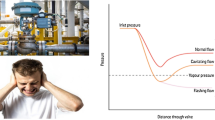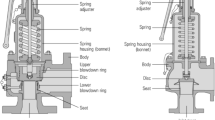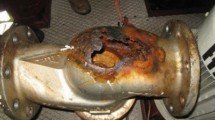Abstract
Safety and instrument engineers regularly analyze the noise in different types of valves to reduce its effect in sectors of the oil and gas industry such as offshore, refineries, and petrochemical plants. This paper reviews the mitigation strategies used to reduce acoustic fatigue and the risk of hearing damage from pressure safety valves and control valves used in piping systems. These two types of valves can generate high-frequency acoustical energy downstream of the valves. Different strategies are used to mitigate noise levels, such as installation of low-noise valves, process optimization to reduce the flow or delta pressure across valves, changing the valve design, acoustic piping installation, and increasing piping thickness. This paper discusses a case study of a noise calculation for a 12″ × 10″ pressure safety valve (PSV) at 1 m and 30 meters from the PSV discharge. The calculated noise level based on API 521, the standard for PSVs, has been compared with the maximum allowable noise limit from PSVs. The maximum allowable noise limit is calculated based on the NORSOK L-002 standard developed by Standards Norway. If the calculated noise level based on API 521 exceeds the allowable or acceptable noise limit based on NORSOK standards, the piping wall thickness should be increased to mitigate the risk of acoustic fatigue. The 12″ 6MO piping wall thickness outlet line of PSV is calculated based on the ASME B31.3 process piping code. The outlet pipe from PSV is in 6MO UNS 31254 material, which is expensive. Fortunately, there is no need to increase the piping wall thickness if the calculated noise based on the API 521 standard is within the accepted noise limit in the NORSOK standard.




Similar content being viewed by others
References
E.I.M Randall, PSV Noise—Criteria, Limits and Prediction. Valve World (2001). [Online]. Available from: http://www.valve-world.net/pdf/SRV_psvnoise.pdf?resourceId=379
Chiyoda Corporation, Acoustic Analysis Technologies and Acoustic Fatigue (2017). [Online]. Available from: https://www.chiyodacorp.com/en/service/chas/acoustic/
J. Shahda, Predicting Control Valve Noise in Gas and Steam Applications: Valve Trim Exit Velocity Head vs. Valve Outlet Mach Number (Dresser Masoneilan, 2010). [Online]. Available from: https://www.plantservices.com/assets/Media/1003/WP_Valve.pdf. Accessed 10 Feb 2019
J. Shahda, Valve Noise Prediction vs. Velocity Head Limitations in Gas Applications (Dresser Masoneilan, 2004). [Online]. Available from: http://www.iceweb.com.au/Valve/Control%20Valves/VelocityHeadLimits.pdf. Accessed 10 Feb 2019
Norwegian Oil and Gas Standard (NORSOK), NORSOK P-001, Process Design, 3rd revision (Lysaker, 1997)
A.C. Fagerlund, Recommended Maximum Valve Noise Level, in Proceedings of the ISA/86 International Conference and Exhibition (Houston, 1986)
H.D. Baumann, Solve valve noise and cavitation problems. Hydrocarb. Process. 76, 45–50 (1997)
STATOIL, Noise control in projects. Guideline, GL0563, 1st revision (Oslo, 2014)
J Monsen, Valve Aerodynamic Noise Reduction Strategies (Valin Corporation, 2011). [Online]. Available from: https://www.valin.com/resources/whitepapers/valve-aerodynamic-noise-reduction-strategies. Accessed 10 Feb 2019
American Petroleum Institute, API Standard 521, Pressure-Relieving and Depressuring Systems, 6th edn. (API, Washington, DC, 2014)
American Society of Mechanical Engineers, ASME B31.3, Process Piping (ASME, New York, 2012)
American Society for Test and Materials, ASTM A312, Standard Specification for Seamless, Welded, and Heavily Cold Worked Austenitic Stainless Steel (USA, 2004)
American Society of Mechanical Engineers (ASME), Valves-Flanged, Threaded, and Welding End (ASME, New York, 2004)
American Society of Mechanical Engineers (ASME), Carbon, Alloy and Stainless Steel Pipes. ASME B36.10/19 (ASME, New York, 2004)
Norwegian Oil and Gas Standard (NORSOK), NORSOK L-002, Piping System Layout, Design and Structural Analysis, 3rd edn (Lysaker, 2009)
Author information
Authors and Affiliations
Corresponding author
Additional information
Publisher's Note
Springer Nature remains neutral with regard to jurisdictional claims in published maps and institutional affiliations.
Rights and permissions
About this article
Cite this article
Sotoodeh, K. Noise and Acoustic Fatigue Analysis in Valves (Case Study of Noise Analysis and Reduction for a 12″ × 10″ Pressure Safety Valve). J Fail. Anal. and Preven. 19, 838–843 (2019). https://doi.org/10.1007/s11668-019-00665-3
Received:
Published:
Issue Date:
DOI: https://doi.org/10.1007/s11668-019-00665-3




